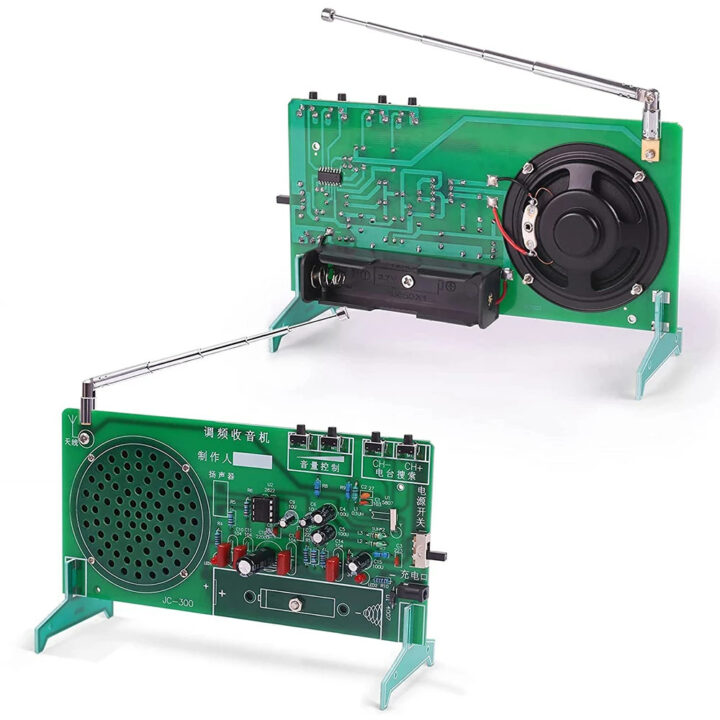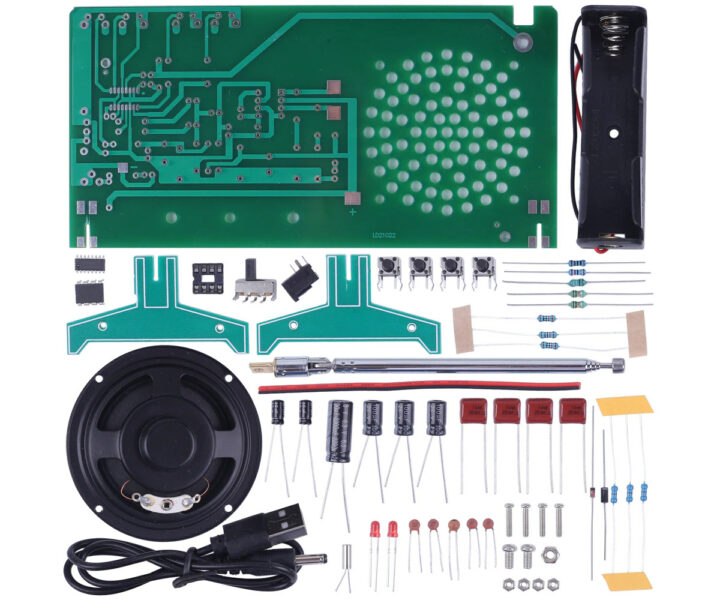 I’ve not used an FM radio for years, but if you’d like to teach younger generations about older technology and show them how to solder components there’s an RDA5807 based kit that would allow you to build DIY FM Radio operating in the 87 MHz to 108 MHz range.
I’ve not used an FM radio for years, but if you’d like to teach younger generations about older technology and show them how to solder components there’s an RDA5807 based kit that would allow you to build DIY FM Radio operating in the 87 MHz to 108 MHz range.
The JC-300 kit comes with a bare PCB, and all components required including a speaker, an antenna, and a holder for a 18650 battery. Some of the main components of the kit include:
- RDK Microelectronics RDA5807 single-chip broadcast FM radio tuner operating in the 87MHz -108MHz frequency range
- DA2822 Power Amplifier
- 66mm speaker
- 75 Ohm FM antenna
- 18650 battery holder
- Feet/brackets to hold the PCB vertically
The system also comes with four buttons to adjust the volume and switch FM stations, plus a power switch.
Nothing is pre-soldered on the bare PCB at all, so everything will have to be soldered and assembled manually. You’ll also need a small Phillips screwdriver, wire cutters, a soldering iron, small gauge solder (1.0mm max recommended), and possibly a magnifying glass. The full step-by-step instructions, as well as the BoM and schematics, can be found in the user manual.
It could make a fun project for kids, and it won’t break the bank as I first found it on IC Station for $13.25, but it’s also available on Aliexpress for $12.61.

Jean-Luc started CNX Software in 2010 as a part-time endeavor, before quitting his job as a software engineering manager, and starting to write daily news, and reviews full time later in 2011.
Support CNX Software! Donate via cryptocurrencies, become a Patron on Patreon, or purchase goods on Amazon or Aliexpress. We also use affiliate links in articles to earn commissions if you make a purchase after clicking on those links.





I’m a complete electronic noob, but I do not see anything for managing 18650 battery protection nor any warning in linked documentation, so beware!
Likely it is intended to use with a consumer-type 18650 cell instead of a bare OEM type cell; these usually have an integral protection circuit. Obviously the documentation is sparse, but the silkscreen showing a battery with a ‘nipple’ leads me to think this, and without looking at the schematic, I don’t see a charge circuit either.
Good catch, neither for anti-deep discharge nor anti-excessive charge. It’s a bit scary :-/ I was thinking about offering one to a kid I know, I’ll be a bit careful.
Yeah, good catch indeed. I am getting my 11 year old son a semi automatic 9mm for Xmas… This circuit is dangerous 🙂
Is it safe to assume all batteries with a nipple come with integrated battery protection? Looking at search results on Amazon, most of the 18650 batteries are of this type, but the descriptions never list any type of protection.
I agree I didn’t notice any direct relation either.
No, definitely not always safe to assume so. Just tends to be the case. I never trust anything without verification! =)
Thanks. I did not know. That’s why I asked :).
But then how does one verify if protection is present without opening (and potentially damaging) the battery? Manufacturers don’t seem to list this at all. Or maybe the only way is to buy a bunch of the same battery, hope for the best, and open one to check…
The schematics is clearly dangerous. You need absolutly a resistor in serial with the input diode rectifier.
Well if I would get one I would just omit the battery(holder).
The design makes an assumption, which should be safe in 80% of the use cases, especially a couple of years back: we use a cheap USB charger with 5-700mA max. at 5V. We dissipate 0.7V over a silicon diode, so we have a pretty safe CC/CV charger.
Not really great, but as I said, omit the battery, use a power bank.
This is an *audio* circuit. Simply replacing the battery with a noisy power supply is likely to have a negative effect on sound quality.
Sound quality…
Don’t forget to use OFC cables for the speaker…
Honestly, this is not a HiFi tuner, and C14 and C15 should be enough albeit not perfect for the amp, the tuner is further decoupled.
Unfortunately the main problem is not LF but HF. I do have a small portable FM radio powered by a 18650. Connecting it to recharge it make it very hard to receive almost any station due to the RF noise emitted by almost all chargers including power banks and that transforms the charging cable to an antenna :-/
True…
So probably better then installing a double AA battery box and omitting the charger port
This is a really fun idea. If my kids were a bit older, I’d absolutely but one of these
“if you’d like to teach younger generations about older technology” .. I don’t think you learn anything about FM or radio if you solder this together. The magic happens in the FM chip …
Give them an RTL-SDR stick, and don’t allow them to eat until they start picking up airplanes with it.
If worried over battery, a search of aliexpress returns other different design using different batteries and no speaker.
Here is a usual limited info, needs headphones self build radio.
https://fave.co/3GOYcTa
Costs £1.89